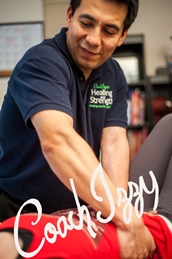Ugh! Injuries! Most of us have experienced them at some point of our lives. They’re a fact of life and don’t have to disable us to get our attention.

Are you active? Chances are you’ve experienced an injury, maybe something as small as a tweak or as major as a tear.
Are you sedentary? You’re not exempt. A sedentary body copes poorly with physical demands. Ever pulled a muscle after picking up an empty trash can?
The Holy Grail of injury therapy is prevention. Everyone talks about taking precautions to diminish the likelihood of an injury. Yet experience has shown me that despite all the precautionary rituals, people still get injured.
Is there anything that can be done? The answer is a qualified yes, meaning that injury prevention is not a black-and-white affair as we’d like it to be. To say that you got injured by a particular exercise, piece of equipment, or exercise class, or that you got injured despite taking all the precautions when you are otherwise healthy, is short-sighted and prevents us from learning valuable lessons.
The nature of injuries is extensive and just saying injuries is as vague as saying just saying water when someone asks what composes a specific spring. Is it cold water? Is it hot water? Is it fresh? Or is it salty? They’re all water but they’re all not the same, nor should be approached as such. But we can simplify the nature of injuries by classifying them based on the events surrounding them. When it comes to injuries, I generally classify them into two major categories:

Evident Injuries – The cause and consequences of these injuries are unequivocal and they often require medical intervention. Think of injuries in the sports field, or motor vehicle accidents, or other unpredictable mishaps where significant mechanical forces disrupted tissue harmony. Once all major physical manifestations recede—as in wounds scar, bones mend, bruises fade, etc.—the injury is considered healed. Their care is often straightforward, which cannot be said of the next type of injuries.
Mysterious Injuries – If you ever threw your back out while bending forward to tie your shoes, or are still dealing with neck pain after sleeping in the wrong mattress, pillow, or position a couple of years ago, or battling the nagging hip pain that showed up after a set of walking lunges, or the chronically inflamed rotator cuff—whatever that means—that followed an ordinary set of overhead presses, then you’re acquainted with mysterious injuries. What caused them? There lies the conundrum and what makes them mysterious, and this is the topic the rest of this article series will analyze.

We don’t take those injuries quietly and our inquisitive nature demands an explanation. But we often let frustration, anger, and despair cloud our rationalization skills and we cling to anything that our desperation believes reasonable—whether real or not. “It has to be the reason! I didn’t do anything crazy!” we often say when facing the pain and limitations.
Lest we take a deep breath and gather our thoughts, we won’t see our own limitations and we’ll look for dubious articles on the web to fill-in the gaps or justify us. Add to the mix the common urge people have to steer blame toward another person or an object, and we have the perfect recipe for some of the most fallacious conclusions one could ever imagine.
Throughout my career in the pain therapy field, I’ve observed that a significant number of these mysterious injuries happened during physical activity. I have also observed during intake that there are three common areas that people blame for their situation. And it is these three targets for blame that I cover in the next segment.
Until next time, may you enjoy a fit and pain-free life!
